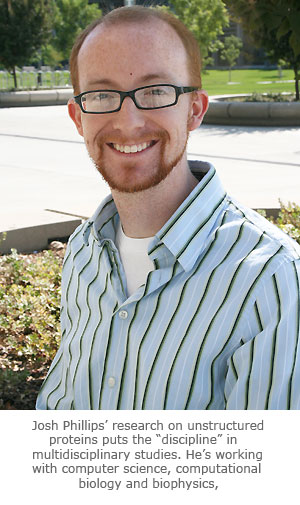

Joshua Phillips considers himself a
computer scientist, but he’s quickly becoming an expert in
molecular dynamics. With any luck, his
computationaltechniques combined with a little intuition will lead to a better understanding of “intrinsically disordered” proteins - proteins that function without ever folding into a unique structure.
Phillips and a group of researchers are defining some of the first tools for studying these proteins - often referred to as unstructured proteins. Existing tools for analyzing molecular dynamic trajectories are not well suited to processes such as protein folding, which is why Phillips gravitated to this area of
research.
“Though scientists have been trying to figure out unstructured proteins for decades, they are still a great mystery for biologists,” Phillips said. “We have been able to fill a niche by taking the information we have been telling them for some time and putting it into a “language’ they can understand.”
As a theorist, Phillips is able to use metric scaling to bring intuitive “snapshots” of how the unstructured proteins are moving to the experimentalists and ask, “Here is what is happening; now what can you do with it?”
Ultimately, he hopes to turn this new data into information drug makers can use.
“We know that many diseases are caused by aggregation of unstructured proteins,” Phillips said. “If we can better understand how these proteins are causing problems, we can figure out how to fix or alleviate them. Then the protein chemists can build drugs that can break them apart.”
Phillips recently received one of eight “Best Poster” awards given at the Protein Society national meeting in Boston for his work in clustering and machine learning techniques to analyze unstructured proteins.
His poster demonstrated the use of spectral clustering methods to analyze the data produced from simulations of several forms from one class of unstructured proteins, the phenylalanine-glycine nucleoporins (FG-Nups). These clustering methods provide a direct, quantitative measure of how effectively single simulations independently sample the motions of unstructured proteins, which offers insights into their biological function.
While working on his doctorate in
computer sciencein
engineeringprofessor
Shawn Newsam’slab, Phillips also collaborates with professor of
computational biology
Mike Colvinand professor of
biophysics
Ajay Gopinathanas well as researchers at UC Santa Cruz, UC Davis and Lawrence Livermore National Laboratory.






